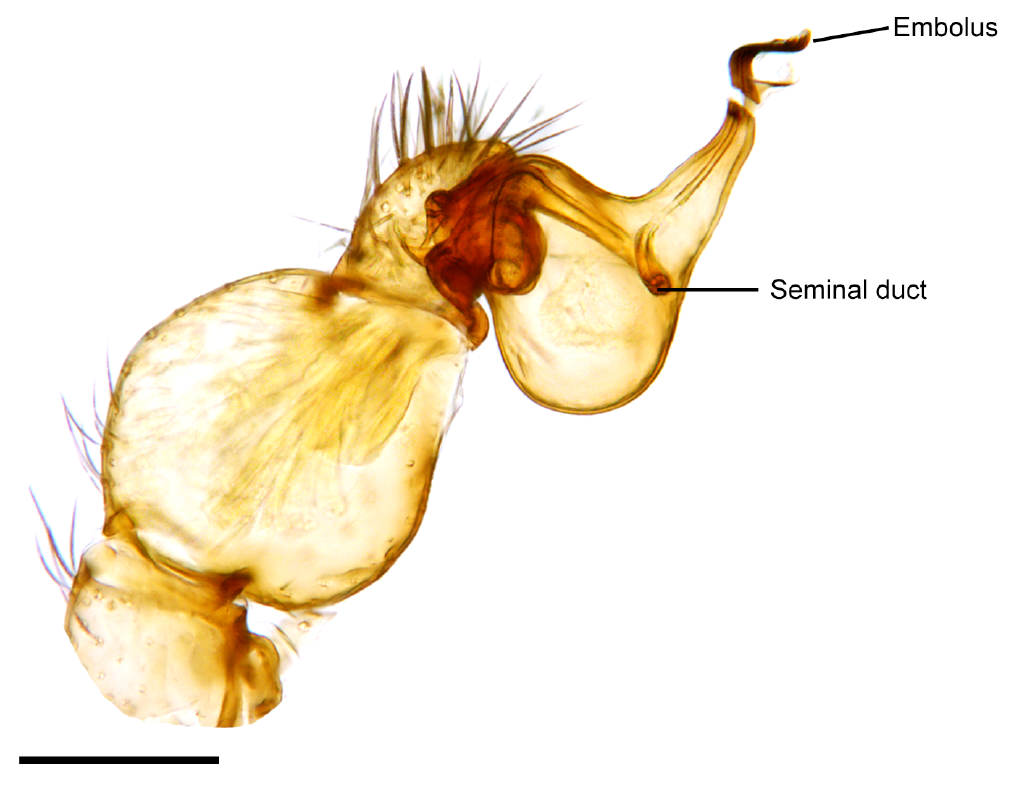|
Nihoa Mahina
The Nihoa trapdoor spider or ''Nihoa mahina'' is a trapdoor spider endemic to Nihoa, Hawaii. These spiders are hunters that dig a hole near rocks cover it with a concealed trapdoor. These burrows are excavated completely with the spider's jaw. When prey approaches or falls in, the spider pounces on it. Then its abnormally large pedipalps are used to take food into the mouth. Prior to the 1980s, trapdoor spiders were not thought to exist in Hawaii. Upon their discovery, the genus was given the name ''Nihoa'', because it was thought to exist nowhere else. Eventually, over 23 species across the Pacific were found. The species epithet, "mahina", means "moon" in the Hawaiian language Hawaiian (', ) is a Polynesian language of the Austronesian language family that takes its name from Hawaii, the largest island in the tropical North Pacific archipelago where it developed. Hawaiian, along with English, is an official language ..., referring how Sheila Conant discovered the spider by ... [...More Info...] [...Related Items...] OR: [Wikipedia] [Google] [Baidu] |
Trapdoor Spider
Trapdoor spider is a common name that is used to refer to various spiders from several different groups that create burrows with a silk-hinged trapdoor to help them ambush prey. Several families within the infraorder Mygalomorphae contain trapdoor spiders: * Actinopodidae, a family otherwise known as 'mouse-spiders', in South America and Australia * Antrodiaetidae, a family of 'folding trapdoor spiders' from the USA and Japan * Barychelidae, a family of 'brush-footed trapdoor spiders' with pantropical distribution * Ctenizidae, a family of ' cork-lid trapdoor spiders' in tropical and subtropical regions * Cyrtaucheniidae, a family of 'wafer-lid trapdoor spiders, with wide distribution except cooler regions * Euctenizidae, a family of spiders that make wafer-like or cork-like trapdoors * Halonoproctidae, a family of spiders that make wafer-like or cork-like trapdoors and includes the phragmotic genus '' Cyclocosmia'' * Idiopidae, a family of 'spurred-trapdoor spiders' or 'arm ... [...More Info...] [...Related Items...] OR: [Wikipedia] [Google] [Baidu] |
Nihoa
Nihoa (; haw, Nīhoa ), also known as Bird Island or Moku Manu, is the tallest of ten islands and atolls in the uninhabited Northwestern Hawaiian Islands (NWHI). The island is located at the southern end of the NWHI chain, southeast of Necker Island. Nihoa is the closest NWHI in proximity to the eight main windward Hawaiian Islands at approximately northwest of the island of Kauai. The island has two peaks, Miller's Peak in the west, and Tanager Peak in the east. Nihoa's area is about and is surrounded by a coral reef. Its jagged outline gives the island its name, , which is Hawaiian for "tooth".. Captain William Douglas, the second Western explorer to find Nihoa, describes the island as " earingthe form of a saddle, high at each end, and low in the middle. To the south, it is covered with verdure; but on the north, west, and east sides it is a barren rock, perpendicularly steep..." The island is home to 25 species of plants and several animals, making it th ... [...More Info...] [...Related Items...] OR: [Wikipedia] [Google] [Baidu] |
Hawaii
Hawaii ( ; haw, Hawaii or ) is a state in the Western United States, located in the Pacific Ocean about from the U.S. mainland. It is the only U.S. state outside North America, the only state that is an archipelago, and the only state geographically located within the tropics. Hawaii comprises nearly the entire Hawaiian archipelago, 137 volcanic islands spanning that are physiographically and ethnologically part of the Polynesian subregion of Oceania. The state's ocean coastline is consequently the fourth-longest in the U.S., at about . The eight main islands, from northwest to southeast, are Niihau, Kauai, Oahu, Molokai, Lānai, Kahoolawe, Maui, and Hawaii—the last of these, after which the state is named, is often called the "Big Island" or "Hawaii Island" to avoid confusion with the state or archipelago. The uninhabited Northwestern Hawaiian Islands make up most of the Papahānaumokuākea Marine National Monument, the United States' largest prot ... [...More Info...] [...Related Items...] OR: [Wikipedia] [Google] [Baidu] |
Pedipalps
Pedipalps (commonly shortened to palps or palpi) are the second pair of appendages of chelicerates – a group of arthropods including spiders, scorpions, horseshoe crabs, and sea spiders. The pedipalps are lateral to the chelicerae ("jaws") and anterior to the first pair of walking legs. Overview Pedipalps are composed of six segments or articles: the coxa, the trochanter, the femur, the short patella, the tibia, and the tarsus. In spiders, the coxae frequently have extensions called maxillae or gnathobases, which function as mouth parts with or without some contribution from the coxae of the anterior legs. The limbs themselves may be simple tactile organs outwardly resembling the legs, as in spiders, or chelate weapons ( pincers) of great size, as in scorpions. The pedipalps of Solifugae are covered in setae, but have not been studied in detail. Comparative studies of pedipalpal morphology may suggest that leg-like pedipalps are primitive in arachnids. At present, the only ... [...More Info...] [...Related Items...] OR: [Wikipedia] [Google] [Baidu] |
Hawaiian Language
Hawaiian (', ) is a Polynesian language of the Austronesian language family that takes its name from Hawaii, the largest island in the tropical North Pacific archipelago where it developed. Hawaiian, along with English, is an official language of the US state of Hawaii. King Kamehameha III established the first Hawaiian-language constitution in 1839 and 1840. For various reasons, including territorial legislation establishing English as the official language in schools, the number of native speakers of Hawaiian gradually decreased during the period from the 1830s to the 1950s. Hawaiian was essentially displaced by English on six of seven inhabited islands. In 2001, native speakers of Hawaiian amounted to less than 0.1% of the statewide population. Linguists were unsure if Hawaiian and other endangered languages would survive. Nevertheless, from around 1949 to the present day, there has been a gradual increase in attention to and promotion of the language. Public Hawaiian-la ... [...More Info...] [...Related Items...] OR: [Wikipedia] [Google] [Baidu] |
Barychelidae
Barychelidae, also known as brushed trapdoor spiders, is a spider family with about 300 species in 42 genera. Most spiders in this family build trapdoor burrows. For example, the long '' Sipalolasma'' builds its burrow in rotted wood, with a hinged trapdoor at each end. The long ''Idioctis'' builds its burrow approximately deep, just below the high tide level, sealing the opening with a thin trapdoor. Some species avoid flooding by plugging their burrows, while others can avoid drowning by trapping air bubbles within the hairs covering their bodies. Some members of this group have a rake on the front surface of their chelicerae used for compacting burrow walls. These spiders can run up glass like tarantulas, and some can stridulate, though it isn't audible to humans. Distribution Barychelids are found in Australia, New Caledonia, South America, Africa, Madagascar, India, New Guinea, and Pacific islands. Genera , the World Spider Catalog accepts the following genera: *'' Am ... [...More Info...] [...Related Items...] OR: [Wikipedia] [Google] [Baidu] |
Endemic Fauna Of Nihoa
Endemism is the state of a species being found in a single defined geographic location, such as an island, state, nation, country or other defined zone; organisms that are indigenous to a place are not endemic to it if they are also found elsewhere. For example, the Cape sugarbird is found exclusively in southwestern South Africa and is therefore said to be ''endemic'' to that particular part of the world. An endemic species can be also be referred to as an ''endemism'' or in scientific literature as an ''endemite''. For example ''Cytisus aeolicus'' is an endemite of the Italian flora. ''Adzharia renschi'' was once believed to be an endemite of the Caucasus, but it was later discovered to be a non-indigenous species from South America belonging to a different genus. The extreme opposite of an endemic species is one with a cosmopolitan distribution, having a global or widespread range. A rare alternative term for a species that is endemic is "precinctive", which applies to s ... [...More Info...] [...Related Items...] OR: [Wikipedia] [Google] [Baidu] |




.jpg)